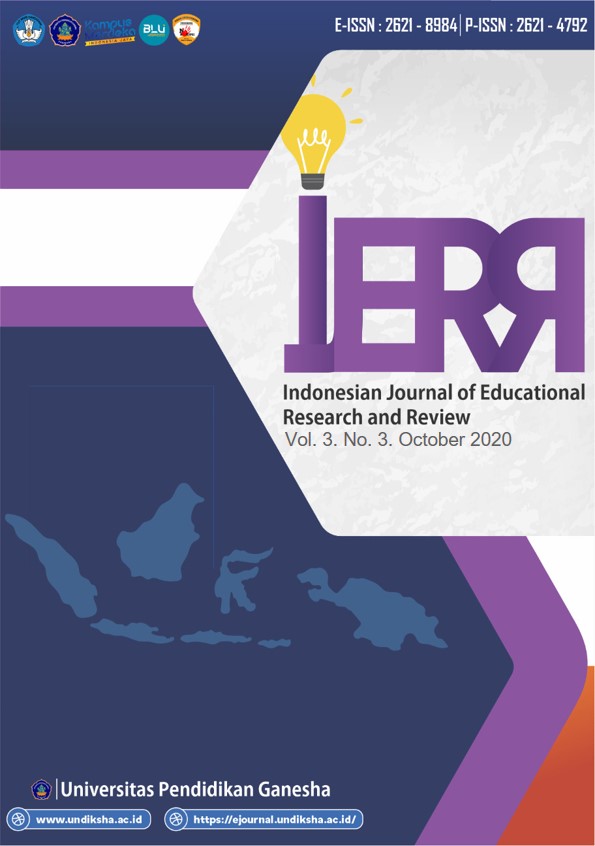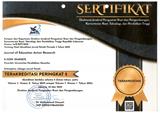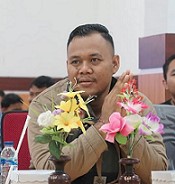STEM on Science Learning in Indonesia: An Opportunity and A Challenge
DOI:
https://doi.org/10.23887/ijerr.v3i3.27660Kata Kunci:
Science, technology, engineering, mathematics, STEM, pembelajaran sainsAbstrak
STEM has become a strategic issue in learning on an international scale, as well as in Indonesia. Related to the term "STEM" in Indonesia, it is often referred to as an approach to learning. This research is a literature study that examines four things, namely, the introduction of STEM, which is an integration of four disciplines (Science, Technology, Engineering, and Mathematics) in learning; Approaches that can be used in STEM implementation are The SILO Approach, The Embedded Approach, and The Integrated Approach; STEM opportunities in science learning in Indonesia can improve concept understanding, problem-solving skills, scientific literacy skills, creative thinking skills, and critical thinking skills; and the challenge when implementing STEM in learning is the demand for teachers to be able to understand the relationship between disciplines in STEM and demands in the technological aspects that all schools in Indonesia cannot meet.
Referensi
Afifah, A. N., Ilmiyati, N., & Toto. (2019). Model project based learning (PjBL) terintegrasi stem untuk meningkatkan penguasaan konsep dan aktivitas belajar siswa. Quagga: Jurnal Pendidikan Dan Biologi, 11(2), 73–78. https://doi.org/10.25134/quagga.v11i2.1915
Afriana, J., Permanasari, A., & Fitriani, A. (2016). Penerapan project based learning terintegrasi STEM untuk meningkatkan literasi sains siswa ditinjau dari gender. Jurnal Inovasi Pendidikan IPA, 2(2), 202. https://doi.org/10.21831/jipi.v2i2.8561
Alfika, Z. A., Mayasari, T., & Kurniadi, E. (2019). Modul STEM Berbasis Pemecahan Masalah dengan Tema Rumah dome. Jurnal Pendidikan Fisika, 7(1), 93. https://doi.org/10.24127/jpf.v7i1.1566
Ariani, L., Sudarmin, & Nurhayati, S. (2019). Analisis berpikir kreatif pada penerapan problem based learning berpendekatan science, technology, engineering, and mathematics. Jurnal Inovasi Pendidikan Kimia, 13(1). https://journal.unnes.ac.id/nju/index.php/JIPK/article/view/15159
Astuti, I. D., Toto, T., & Yulisma, L. (2019). Model project based learning (pjbl) terintegrasi stem untuk meningkatkan penguasaan konsep dan aktivitas belajar siswa. Quagga: Jurnal Pendidikan Dan Biologi, 11(2), 93–98. https://doi.org/10.25134/quagga.v11i2.1915
Barlex, D. (2011). The Stem Programme in England. In Positioning Technology Education in the Curriculum (pp. 63–74). Deft, The Netherland: Sense Publishers. https://doi.org/10.1007/978-94-6091-675-5_6
Breiner, J. M., Harkness, S. S., Johnson, C. C., & Koehler, C. M. (2012). What Is STEM? A Discussion About Conceptions of STEM in Education and Partnerships. School Science and Mathematics, 112(1), 3–11. https://doi.org/10.1111/j.1949-8594.2011.00109.x
Bybee, R. W. (2010). What is STEM education? Science, 329(5995), 996. https://doi.org/10.1126/science.1194998
Bybee, R. W. (2015). The Case for STEM Education: Challenges and Opportunities. The Case for STEM Education: Challenges and Opportunities. Arlington, Virginia: NSTA Press. https://doi.org/10.2505/9781936959259
Chen, M. (2001). A potential limitation of embedded-teaching for formal learning. In J. Moore & K. Stenning (Eds.),. In Proceedings of the Twenty-Third Annual Conference of the Cognitive Science Society (pp. 194-199). Edinburgh, Scotland: Lawrence Erlbaum Associates, Inc. https://escholarship.org/uc/item/7zk693xc
Cuadra, E., & Moreno, J. (2005). Expanding Opportunities and Building Competencies for Young People. Expanding Opportunities and Building Competencies for Young People. Washington, DC: The World Bank. https://doi.org/10.1596/0-8213-6170-8
Dewi, M., Kaniawati, I., & Suwarma, I. R. (2018). Penerapan pembelajaran fisika menggunakan pendekatan STEM untuk meningkatkan kemampuan memecahkan masalah siswa pada materi listrik dinamis. Seminar Nasional Quantum. Yogyakarta. http://seminar.uad.ac.id/index.php/quantum/article/view/287
Dugger, W. E. (2010). Evolution of STEM in the United States. 6Th Biennial International Conference on Technology Education Research, (March), 1–8. https://doi.org/10.1.1.476.5804
English, L. D. (2016). STEM education K-12: perspectives on integration. English International Journal of STEM Education, 3(1), 1–8. https://doi.org/10.1007/s10763-017-9802-x
Furner, J. M., & Kumar, D. D. (2007). The mathematics and science integration argument: A stand for teacher education. Eurasia Journal of Mathematics, Science and Technology Education, 3(3), 185–189. https://doi.org/10.12973/ejmste/75397
Gee, K. A., & Wong, K. K. (2012). A cross national examination of inquiry and its relationship to student performance in science: Evidence from the Program for International Student Assessment (PISA) 2006. International Journal of Educational Research, 53, 303–318. https://doi.org/10.1016/j.ijer.2012.04.004
Gough, A. (2015). STEM policy and science education: scientistic curriculum and sociopolitical silences. Cultural Studies of Science Education, 10(2), 445–458. https://doi.org/10.1007/s11422-014-9590-3
Harden, R. M. (2000). The integration ladder: A tool for curriculum planning and evaluation. Medical Education. https://doi.org/10.1046/j.1365-2923.2000.00697.x
Ismail, I., Permanasari, A., & Setiawan, W. (2016). Efektivitas virtual lab berbasis STEM dalam meningkatkan literasi sains siswa dengan perbedaan gender. Jurnal Inovasi Pendidikan IPA, 2(2), 190–201. https://doi.org/10.21831/jipi.v2i2.8570
Jardine, W. D. (2006). On the Integrity of Things: Reflections on the 'Integrated Curriculum". In Curriciculum in Abundance (pp. 171–176). Mahwah, NJ: Erlbaum. https://www.taylorfrancis.com/books/e/9780429238598/chapters/10.4324/9780203826133-28
Johnston, J. (2011). The impact of home and school on early years scientific development. Education in Science, (245), 30–31. https://eric.ed.gov/?id=EJ954452
Kelley, T. R., & Knowles, J. G. (2016, December 1). A conceptual framework for integrated STEM education. International Journal of STEM Education. Springer. https://doi.org/10.1186/s40594-016-0046-z
Klein, J. T. (2005). Foundation for Integrative Education, par. Aac&U, Sum/Fall(Hopkins 1937), 8–10. https://www.juniata.edu/academics/departments/integrated-media-arts/media/integrative-learning-and-interdisciplinary.pdf
Komarudin, U., Rustaman, N. Y., & Hasanah, L. (2017). Promoting students’ conceptual understanding using STEM-based e-book. In AIP Conference Proceedings (Vol. 1848, p. 60005). American Institute of Physics Inc. https://doi.org/10.1063/1.4983976
Lestari, D. A. B., Astuti, B., & Darsono, T. (2018). Implementasi LKS Dengan Pendekatan STEM (Science, Technology, Engineering, And Mathematics) Untuk Meningkatkan Kemampuan Berpikir Kritis Siswa. Jurnal Pendidikan Fisika Dan Teknologi, 4(2), 202. https://doi.org/10.29303/jpft.v4i2.809
Marginson, S., Tytler, R., Freeman, B., & Roberts, K. (2013). STEM: Country comparisons. Report for the Australian Council of Learned Academies. The Australian Council of Learned Academies, 178. https://doi.org/ISBN 978 0 9875798 0 5
Melati, L. T., Warsono, & Toto. (2019). Pengaruh model problem based learning berbasis STEM terhadap penguasaan konsep dan kemampuan berpikir kritis siswa. Bioed: Jurnal Pendidikan Biologi, 7(2). https://ojs.unigal.ac.id/index.php/bioed/article/view/2197
Moomaw, S. (2013). Teaching STEM in the early years : activities for integrating science, technology, engineering, and mathematics. St. Paul, MN: Redleaf Press.
Morrison, J, & Bartlett, R. (2009). STEM as curriculum. Education Week, 23.
Morrison, Janice. (2006). TIES STEM Education Monograph Series: Attributes of STEM Education - The Student, The Academy, The Classroom. Teaching Institute for Essensial Science, 6, 0–6.
National Research Council. (2011). Successful K-12 STEM Education: Identifying Effective Approaches in Science, Technology, Engineering, and Mathematics. 978-0-309-21296-0. Washington, DC: National Academy Press. https://doi.org/10.17226/13158
Pangesti, K. E., Yulianti, D., & Sugianto. (2017). Bahan Ajar Berbasis STEM (Science, Technology, Engineering, and Mathematics) untuk Meningkatkan Penguasaan Konsep Siswa SMA. Unnes Physics Education Journal, 6(3), 53–58. Retrieved from http://journal.unnes.ac.id/sju/index.php/upej
Pimthong, P., & Williams, J. (2018). Preservice teachers’ understanding of STEM education. Kasetsart Journal of Social Sciences, xxx, 1–7. https://doi.org/10.1016/j.kjss.2018.07.017
Pinar, W. F., Reynolds, W. M., Slattery, P., & Taubman, P. . (2000). Understanding curriculum: An introduction to the study of historical and contemporary curriculum discourses. New York: Peter Lang Publishing. https://doi.org/10.26522/brocked.v13i1.45
Pranita, M. Y., Wisodo, H., & Yuliati, L. (2019). Penguasaan Konsep Peserta Didik pada Materi Usaha dan Energi melalui Pembelajaran Authentic Berbasis Inquiry for STEM Education. Jurnal Pendidikan: Teori, Penelitian, Dan Pengembangan, 4(6), 720–725. http://journal.um.ac.id/index.php/jptpp/
Rivai, H. P., Yuliati, L., & Parno. (2018). Penguasaan Konsep dengan Pembelajaran STEM Berbasis Masalah Materi Fluida Dinamis pada Siswa SMA. Jurnal Pendidikan: Teori, Penelitian, Dan Pengembangan, 3(8), 1080–1088. http://journal.um.ac.id/index.php/jptpp/
Roberts, A., & Cantu, D. (2012). Applying STEM Instructional Strategies to Design and Technology Curriculum. PATT 26 Conference; Technology Education in the 21st Century, 111–118. http://www.ep.liu.se/ecp/article.asp?issue=073&volume=&article=013
Rossouw, A., Hacker, M., & De Vries, M. J. (2011). Concepts and contexts in engineering and technology education: An international and interdisciplinary delphi study. International Journal of Technology and Design Education, 21(4), 409–424. https://doi.org/10.1007/s10798-010-9129-1
Sagala, R., Umam, R., Thahir, A., Saregar, A., & Wardani, I. (2019). The effectiveness of stem-based on gender differences: The impact of physics concept understanding. European Journal of Educational Research, 8(3), 753–761. https://doi.org/10.12973/eu-jer.8.3.753
Sanders, M. (2009). Integrative STEM Education: Primer. The Technology Teacher, December/J(September), 20–26.
Siswanto, J. (2018). Keefektifan Pembelajaran Fisika dengan Pendekatan STEM untuk Meningkatkan Kreativitas Mahasiswa. Jurnal Penelitian Pembelajaran Fisika, 9(2). https://doi.org/10.26877/jp2f.v9i2.3183
Stohlmann, M., Moore, T. J., McClelland, J., & Roehrig, G. H. (2011). Impressions of a Middle Grades STEM Integration Program: Educators Share Lessons Learned from the Implementation of a Middle Grades STEM Curriculum Model. Middle School Journal, 43(1), 32–40. https://doi.org/10.1080/00940771.2011.11461791
Sugiyono. (2012). Metode Penelitian Pendidikan (Pendekatan Kuantitatif, Kualitatif dan R&D. Alfabeta.
Sukmawijaya, Y., Suhendar, & Juhanda, A. (2019). Pengaruh Model Pembelajaran Stem-Pjbl Terhadap Kemampuan Berpikir Kreatif Siswa. Jurnal Program Studi Pendidikan Biologi, 9(9), 28–43. http://journal.uinsgd.ac.id/index.php/bioeduin/article/view/5893
Talley, T. (2016). The STEM Coaching Handbook. The STEM Coaching Handbook. New York: Routledge.
Thomson, S., De Bortoli, L., & Underwood, C. (2017). PISA 2015: Reporting Australia’s results. https://research.acer.edu.au/ozpisa/22/
UNESCO. (2015). Education 2030 and framework for action for the implementation of sustainable development goal 4: Towards inclusive and equitable quality education. http://unesdoc.unesco.org/images/0024/002456/%0A245656E.pdf
Utami, T. N., Jatmiko, A., & Suherman, S. (2018). Pengembangan Modul Matematika dengan Pendekatan Science, Technology, Engineering, And Mathematics (STEM) pada Materi Segiempat. Desimal: Jurnal Matematika, 1(2), 165.
Wang, H.-H., Moore, T. J., https://doi.org/10.24042/djm.v1i2.2388Roehrig, G. H., & Park, M. S. (2011). STEM Integration : Teacher Perceptions and Practice STEM Integration : Teacher Perceptions and Practice. Journal of Pre-College Engineering Education Research (J-PEER), 1(2), 1–13. https://doi.org/10.5703/1288284314636
Watts, T. W., Duncan, G. J., Siegler, R. S., & Davis-Kean, P. E. (2014). What’s Past Is Prologue: Relations Between Early Mathematics Knowledge and High School Achievement. Educational Researcher, 43(7), 352–360. https://doi.org/10.3102/0013189X14553660
Webb, D. (2013). STEM Lesson Essentials, Grades 3-8: integrating Science, Technology, Engineering, and Mathematics. Teacher Education Practice, 26(2), 358–364.
Widya, Rifandi, R., & Rahmi, Y. L. (2019). STEM education to fulfil the 21st century demand: A literature review. In Journal of Physics: Conference Series (Vol. 1317). https://doi.org/10.1088/1742-6596/1317/1/012208
Yuanita, Y., & Kurnia, F. (2019). Pengembangan bahan ajar berbasis stem (science, technology, engineering, and mathematics) materi kelistrikan untuk sekolah dasar. Profesi Pendidikan Dasar, 6(2), 199–210. https://doi.org/10.23917/ppd.v1i2.9046
Zollman, A. (2012). Learning for STEM Literacy: STEM Literacy for Learning. School Science and Mathematics, 112(1), 12–19. https://doi.org/10.1111/j.1949-8594.2012.00101.x
Unduhan
Diterbitkan
Cara Mengutip
Terbitan
Bagian
Lisensi
Authors who publish with the Indonesian Journal of Educational Research and Review (IJERR) agree to the following terms:
- Authors retain copyright and grant the journal the right of first publication with the work simultaneously licensed under a Creative Commons Attribution License (CC BY-SA 4.0) that allows others to share the work with an acknowledgment of the work's authorship and initial publication in this journal.
- Authors are able to enter into separate, additional contractual arrangements for the non-exclusive distribution of the journal's published version of the work (e.g., post it to an institutional repository or publish it in a book), with an acknowledgment of its initial publication in this journal.
- Authors are permitted and encouraged to post their work online (e.g., in institutional repositories or on their website) prior to and during the submission process, as it can lead to productive exchanges, as well as earlier and greater citation of published work. (See The Effect of Open Access)












